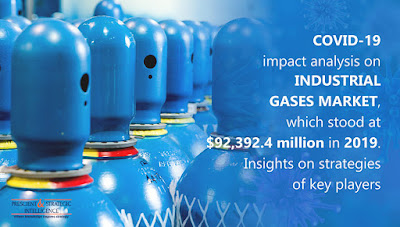How Is COVID-19 Pandemic Affecting Demand for Industrial Gases?
With the continuous population growth and its migration to cities, manufacturing output is growing around the world. Considering how diverse the things made in factories are, the raw materials used to create them are equally diverse. One of the key raw materials used across industries is several types of gases, such as oxygen, hydrogen, nitrogen, carbon dioxide, acetylene, argon, and helium, either as ingredients in the intermediate or final products or to support various manufacturing processes.
Thus, with the growing manufacturing output, the industrial gases market revenue is set to reach $154,079.5 million by 2030 from $92,392.4 million in 2019, at a 5.5% CAGR during 2020–2030 (forecast period). Thus, seeing the widening scope for themselves, market players are entering into mergers and acquisitions to expand their portfolio, geographical reach, technical knowledge, and customer pool. For instance, in October 2018, Praxair Inc. and Linde AG merged to cumulatively increase their revenue. Similarly, Air Liquide S.A. acquired Baywater Healthcare Ireland Limited in June 2015 to grow its Irish home healthcare business.
Geographically, the Asia-Pacific industrial gases market generated the highest revenue in 2019, and it will continue to do so during the forecast period. The rising number of production units in South Korea, India, Japan, and China due to cheap labor, flexible environment laws, and increasing demand for end products is driving the market growth. For instance, the manufacturing sector of China and Japan stood at $4.0 trillion and $1.0 trillion, respectively, during 2018–2019, which reflects the consumption of numerous gases in huge volumes.
In addition to the largest share, the APAC industrial gases market will grow the fastest during the forecast period. It can be attributed to the surge in the population and increase in the purchasing power of the people in the region. The shift of manufacturing units from Western countries to the APAC region due to the increasing demand for end-use products in the latter will also add to the fast-paced growth of the market, as will the surging expenditure on healthcare in the emerging nations of the region.
Therefore, the growing number of production units, to cater to the demand for the end-use products, will lead to the rising consumption of gases in factories.



Comments
Post a Comment